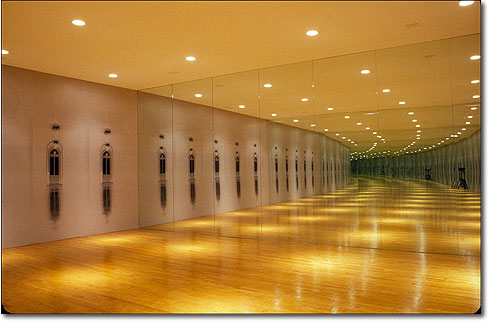Bronx Museum,
Oct 30, 2003 - Mar 14, 2004
Bronx, NY, USA
Valeska Soares
by Kelly Linder
Brazilian-born artist, Valeska Soares’ recent survey at the Bronx Museum of the Arts, the artist’s first museum exhibition in the United States, included primarily sculptural works from 1996-2003 and presented an overview of the artist’s recurring interest in illusion, fiction, mirrors, and gardens. Like a number of other artists working today, such as Teresita Fernandez, Rachael Whiteread, Polly Apfelbaum, Soares repositions the cool, geometric aesthetic of minimalism through a lens of narrative and reference. Literary texts figure prominently in Soares’ work and Italo Calvino in particular has been a favorite muse for Soares. Borrowing from Calvino’s "Invisible Cities," for two of the works in the exhibition Soares builds upon the author’s magical story-telling to create parallel visual metaphors. Like the Mirrored Hall at Versailles, the maze of reflections in Soares’ installation "Detour" becomes a cul-de-sac of fragmented images. Two of the walls in the enclosed space are papered with the photographic image of an arched doorway and its slightly obscured reflection, as if the floors were polished to a glossy shine or the door opened onto a reflecting pool. Mirrors placed on the adjacent walls create the illusion of an endless series of doorways and reflections. A mirrored hall materializes. An audio component quietly permeates the space with different storytellers recounting from the memory a short story by Italo Calvino. Fragments of the story include " a woman is lost", "she disappeared", "there was no avenue of escape." In Calvino’s tale the building of the city Zobeide is inspired by a collective dream in which a woman is chased through the streets of a white city. Her pursuers, never able to catch up with her in the dream, reconfigure the streets of their new city in hopes of trapping her. The woman, however, is never seen again. Like the story, "Detour" articulates a tension between illusion and reality, memory and fact. The dream-like qualities are countermanded by the realization that, like the story, the doorways depicted offer no exit. Similar to "Detour," "Picturing Paradise" employs the literal reflection of mirrors to comment on illusion and reality. Comprised of two sets of paired mirrors that meet at right angles, which for this exhibition were placed in opposite corners of the gallery, one side of each pair contains the tale of Valdrada, another city described in Calvino’s "Invisible Cities" etched into the glass. The story appears in both Spanish and English although etched in reverse and only able to be read in the reflection in the adjacent mirror. The piece was originally commissioned by InSite 2000 and installed on the border between Tiajuana and San Diego. Soares builds a parallel between Calvino’s mirror-image city of Valdrada (a city built on a lake resulting in a competition with its own reflection) and the underlying political tensions that exist between the U.S. and Mexican border towns even as they may benefit one another. The site-specificity of the original installation, however adds potency to the visual experience of the work. Removed from the politicized context that inspired it, "Picturing Paradise", while certainly poetic, slips into a visual illustration of the Calvino story. "Untitled (from historias)" also suffers from the shift into a neutral gallery space. Commissioned by the Public Art Fund in 1998 for the Metrotech Center in Brooklyn, the installation consists of a series of engraved copper rings originally installed on the trunks of trees in a public space. For the Bronx Museum the rings were displayed on a cluster of columns. Each ring bears a different quote taken from literary texts that include the word "garden". Ranging from Sir Max Pemberton’s, "The garden of
|











